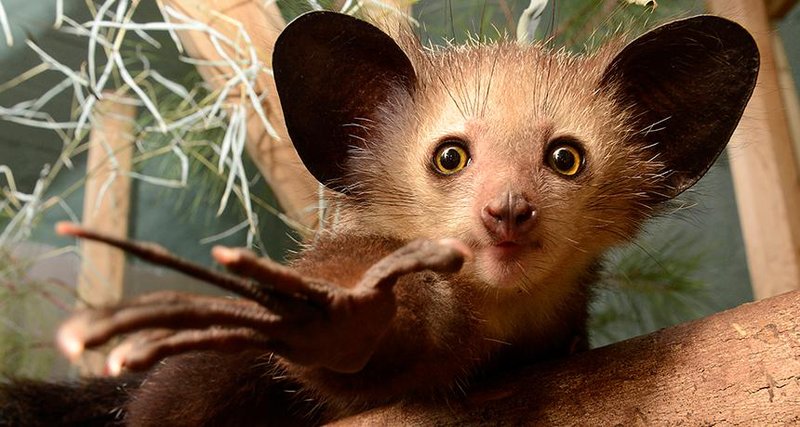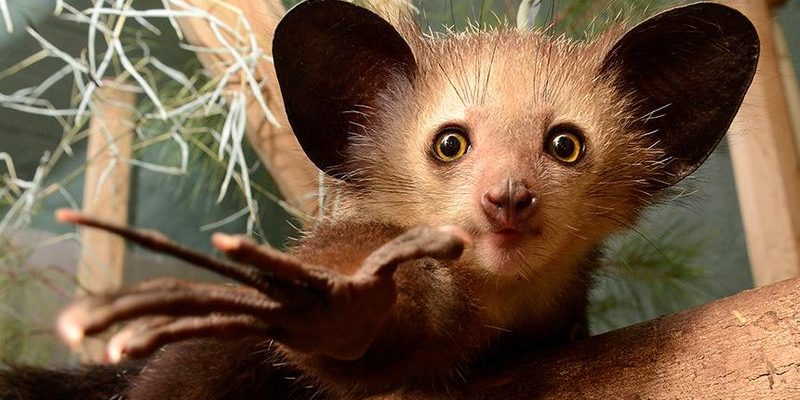
The aye-aye is more than just a woodland oddity; it’s an essential player within its habitat. Its unusual feeding habits and behaviors help maintain the balance of its ecosystem. So, let’s dive into the world of this fascinating creature and explore how it contributes to its environment, ensuring the forest continues to thrive.
What is an Aye-Aye?
You might be wondering, what exactly is an aye-aye? This remarkable creature, known scientifically as *Daubentonia madagascariensis*, is a type of lemur native to Madagascar. Aye-ayes are nocturnal, meaning they’re most active at night, which adds to their mysterious charm. With a body size similar to that of a domestic cat, they possess an elongated middle finger that they use for foraging. This unique finger is a crucial tool in their feeding technique, allowing them to tap on trees to find hollow spaces where insects live.
These primates have a distinct look: large, round eyes that help them see in the dark, large ears that can detect the slightest sounds, and fur that’s mostly dark with some lighter patches. Their appearance might leave you thinking they’re not the prettiest creatures out there, but they’re definitely one of the most interesting!
Foraging Behavior and Its Importance
Aye-ayes are primarily insectivorous, meaning they love to munch on insects. But not just any insects—they have a special preference for wood-boring larvae hidden deep inside trees. Their foraging technique is fascinating. They tap on tree trunks with their fingers, listening for sounds that indicate the presence of larvae. Once they find a spot, they create a small hole using their incisors and then use their long, thin middle finger to retrieve the larvae.
This behavior isn’t just unique; it plays a vital role in the ecosystem. By excavating these larvae, aye-ayes help maintain tree health. Without their foraging, many insects would thrive unchecked, potentially harming the trees and altering the entire forest structure. Think of the aye-aye as a miniature gardener, ensuring that the forest doesn’t become overrun with pests.
The Aye-Aye and Seed Dispersal
Besides being insect hunters, aye-ayes also contribute to their ecosystem through seed dispersal. When they consume fruits and nuts, they often leave behind seeds that can sprout into new plants. This natural process helps maintain biodiversity in the forest.
Here’s the thing: by aiding in the growth of new plants, aye-ayes indirectly support the entire food web. More plant life means more food and habitat for various animals. So, every time an aye-aye devours a fruit and scatters its seeds, it’s like they’re planting new trees and bushes without even realizing it!
Interactions with Other Species
The aye-aye’s unique lifestyle and diet mean that it interacts with various species within its habitat. For example, many birds and insects rely on the same trees for food and shelter. By tapping and digging into these trees, aye-ayes can sometimes create openings that allow these other species access to food or nesting sites.
This interaction contributes to a complex web of relationships in the forest. Each species, including the aye-aye, plays a part that helps maintain the balance of the ecosystem. It’s a reminder of how interconnected life can be—what one creature does can have ripple effects throughout their environment.
Conservation Status and Challenges
Despite their fascinating role in the ecosystem, aye-ayes face significant challenges. Habitat loss, primarily due to deforestation and agriculture, poses a serious threat to their existence. The International Union for Conservation of Nature (IUCN) lists the aye-aye as endangered, which means we need to pay attention to their plight.
Moreover, these creatures are often misunderstood. In some cultures, the aye-aye has been associated with superstition and considered an omen of bad luck. This has led to fear-driven killings and further reduced their populations. Protecting the aye-aye isn’t just about saving a quirky animal; it’s about preserving an integral part of the ecosystem that sustains many other living beings.
How Can We Help Protect the Aye-Aye?
So, what can we do to help? First off, raising awareness about the aye-aye and its vital role is essential. The more people understand how these creatures contribute to their ecosystem, the more likely they are to support conservation efforts.
Here are some practical steps we can take to help protect the aye-aye and its habitat:
- Support conservation organizations: Many groups are dedicated to protecting Madagascar’s unique wildlife.
- Educate others: Share what you learn about the aye-aye—knowledge is powerful!
- Avoid products that contribute to deforestation: Making informed choices can help preserve precious habitats.
Every little action counts. Together, we can make a difference for the aye-aye and the vibrant ecosystems they help sustain.
The Aye-Aye: An Ecosystem Hero
In conclusion, the aye-aye might look unusual, but its impact on the ecosystem is anything but. From foraging for larvae to dispersing seeds, this little primate plays numerous essential roles in maintaining the health and balance of its habitat. Understanding and protecting the aye-aye is crucial for preserving not just this unique species but the entire ecosystem of Madagascar.
So, the next time you hear about this intriguing creature, remember: it’s not just a quirky oddball; it’s a vital part of a larger story. And in a way, we’re all connected in this beautiful narrative of life on Earth. Let’s work together to ensure that the aye-aye and its forest home thrive for generations to come.

